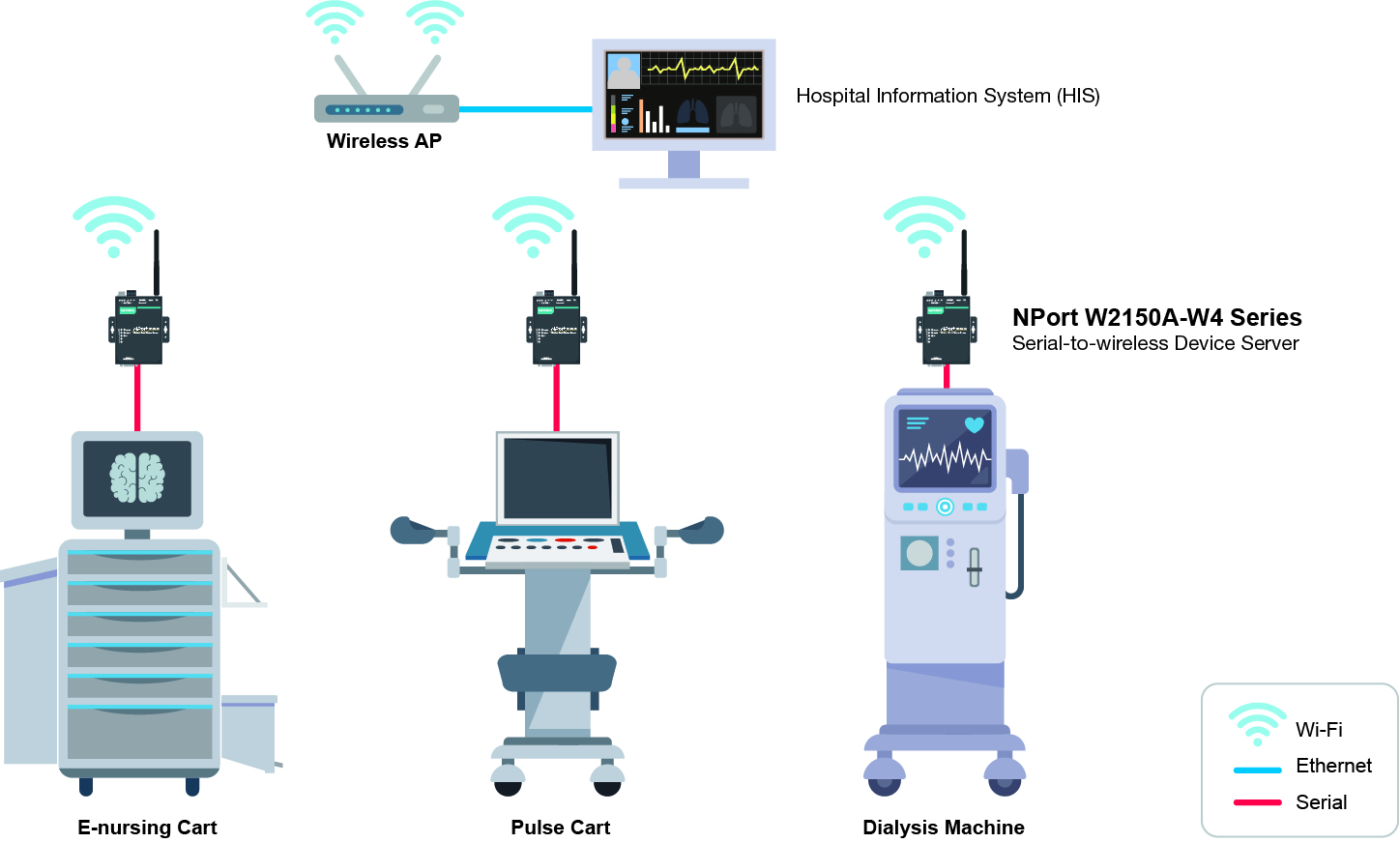Given the prevalent technology nowadays, healthcare sectors are swiftly shifting towards digitalization. The drive to reduce human errors and boost operational efficiency fuels this push for digitalization that emphasizes the creation of electronic health records (EHRs). Notably, the demand for EHRs has increased rapidly due to the impact of COVID-19, necessitating quick and efficient access to patient data by medical personnel in real-time to enhance their productivity.
The development of EHRs involves gathering a vast amount of data from numerous medical devices spread across different hospital premises. Consequently, many healthcare providers are actively constructing their medical center information systems (HISs) to aggregate data from these widely dispersed medical devices and transform valuable information into EHRs. Given that several medical devices come with serial interfaces, there is a reliance on serial-to-Ethernet communication to accommodate a modern HIS. These devices encompass a wide range of equipment like dialysis machines, blood glucose and blood pressure monitoring systems, medical carts, diagnostic mobile workstations, ventilators, anesthesia machines, ECGs, etc. Establishing a dependable communication framework between the HIS and medical devices is, therefore, of utmost importance. Inadequate connections can lead to a HIS being unable to receive timely and accurate data necessary for generating a proper EHR. These scenarios result in ineffective diagnoses and slower treatment procedures, defeating the purpose of EHR development. Given the crucial role serial device servers play in facilitating data exchange between serial-based medical devices and an Ethernet-based HIS, selecting a reliable serial device server is vital to ensure robust connectivity. In this guide, we will explore three key considerations to keep in mind when opting for connectivity solutions to construct a reliable HIS and the advantages these solutions provide.
Aspect 1: Managing Connectivity with Perpetually Mobile Medical Devices
Several medical devices necessitate constant movement from one location to another to cater to different patients. Wireless communications can resolve connectivity challenges for such mobile medical devices. Hence, utilizing a serial device server that supports wireless connections can aid in linking your mobile medical devices to a HIS via wireless networks. While wireless connections offer convenience, maintaining their stability is challenging. If you opt for establishing wireless networks, you must ensure an adequate number of Access Points (APs) are installed in your hospital to keep your medical devices connected while on the move. As medical devices transition between different APs, your serial-to-wireless device servers must perform swift roaming to minimize switching time and reduce the odds of disconnection. In instances of wireless disconnection and instability, the port buffering function serves as a valuable asset for your serial-to-wireless communication by enabling you to store serial data and resend it when wireless connectivity is restored. Therefore, when selecting a serial-to-wireless device server, verify if this feature is available as it can significantly assist HISs in capturing complete serial data from medical devices.
Aspect 2: Safeguarding Sensitive Patient Data from Unauthorized Intrusions
Enhancing communication boosts efficiency but also raises security concerns. Hospital records contain sensitive patient information necessitating stringent protection. Hence, while choosing your serial-to-wireless device servers, ensure they can safeguard your data during wireless transmissions. Look for features such as WPA2 protocol support to establish a secured wireless connection that encrypts your serial data over wireless networks. Furthermore, your serial-to-wireless device servers should endorse secure boots that exclusively permit authorized firmware to operate on your devices, thereby lowering hacking risks.
Aspect 3: Shielding Communication Systems from Disruptions
Medical devices are intolerant of system downtime. Consequently, the serial-to-wireless device servers you select should offer high reliability to minimize system interruptions. Providing a locking screw for stable power input against constant shocks and vibrations caused by moving medical carts should be a primary feature. Additionally, incorporating features like surge protection for your serial ports, power inputs, and LAN ports also enhances reliability while reducing system downtime.
Dependable and Secure Serial-to-wireless Device Servers
Our NPort W2150A-W4/W2250A-W4 Series serial-to-wireless device server delivers secure and reliable serial-to-wireless communications for your HIS. These servers offer 802.11 a/b/g/n dual-band network connectivity, seamlessly connecting your serial-based medical devices with a contemporary HIS. To diminish packet loss over wireless networks, our serial-to-wireless device servers support a fast roaming function, ensuring smooth connectivity for constantly mobile medical carts across different wireless APs. Furthermore, our offline port buffering function grants up to 20 MB storage for your data in situations of unstable wireless connectivity. To safeguard sensitive patient information, our serial-to-wireless device servers endorse secure boots and WPA2 protocol to heighten device and wireless transmission security.
As a provider of industrial connectivity solutions, our serial-to-wireless device servers offer locking screws with power inputs and surge protection to enhance device reliability, thereby reducing the risk of system downtime.

NPort W2150A-W4/W2250A-W4 Series Serial-to-wireless Device Servers
- Connect serial and Ethernet devices to an IEEE 802.11a/b/g/n network
- Configure via web-based interface using built-in Ethernet or WLAN
- Secure boot to run solely Moxa authorized firmware
- Ensure data security with WEP, WPA, WPA2
- Enable fast roaming for seamless automatic AP switching
- Feature offline port buffering and serial data logging
- Offer enhanced surge protection for serial, LAN, and power interfaces
- Include dual power inputs (1 screw-type power jack, 1 terminal block)
- Backed by a 5-year warranty guaranteeing product longevity and excellence
Moxa is dedicated to delivering serial connectivity solutions that seamlessly transition your serial devices into the realm of networking. We are continually innovating, supporting various OS drivers, and enhancing cybersecurity features, ensuring your connectivity needs are met well beyond the year 2030. Explore more about our serial connectivity solutions.
- Not Only for Automobiles: Discovering CANbus Technology in Various Industrial Settings - October 29, 2024
- Boost Your Network Performance: An Exciting Manual to PoE Switches! - September 10, 2024
- Understanding Gigabit Switches: Industrial vs Regular Gigabit - September 4, 2024


